Related Research Articles
A music workstation is an electronic musical instrument providing the facilities of:

A sampler is an electronic musical instrument that records and plays back samples. Samples may comprise elements such as rhythm, melody, speech, sound effects or longer portions of music.
The Ensoniq Mirage is one of the earliest affordable sampler-synths, introduced in 1984 as Ensoniq's first product. Introduced at a list price of $1,695 with features previously only found on more expensive samplers like the Fairlight CMI, the Mirage sold nearly 8,000 units in its first year - more than the combined unit sales of all other samplers at that time. The Mirage sold over 30,000 units during its availability.
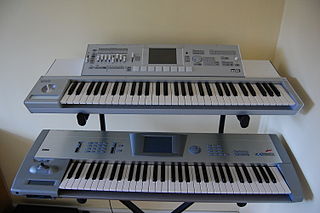
The Korg Triton is a music workstation synthesizer, featuring digital sampling and sequencing, released in 1999. It uses Korg's "HI Synthesis" system and was eventually available in several model variants with numerous upgrade options. The Triton became renowned as a benchmark of keyboard technology, and has been widely featured in music videos and live concerts. At the NAMM Show in 2007, Korg announced the Korg M3 as its successor.
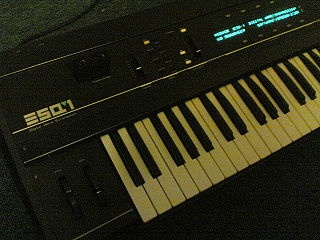
Ensoniq ESQ-1 is a 61-key, velocity sensitive, eight-note polyphonic and multitimbral synthesizer released by Ensoniq in 1985. It was marketed as a "digital wave synthesizer" but was an early Music Workstation. Although its voice generation is typically subtractive in much the same fashion as most analog synthesizers that preceded it, its oscillators are neither voltage nor "digitally controlled", but true digital oscillators, provided by a custom Ensoniq wavetable chip. The signal path includes analog resonant low-pass filters and an analog amplifier.
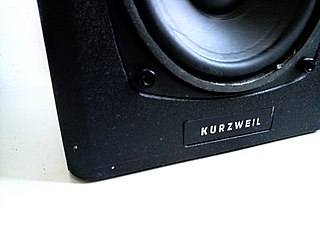
Kurzweil Music Systems is an American company that produces electronic musical instruments. It was founded in 1982 by Stevie Wonder (musician), Ray Kurzweil (innovator) and Bruce Cichowlas.

The Ensoniq MR61 is a 61-key music workstation synthesizer that Ensoniq released in 1996. It features a 16-track sequencer, digital effects, and several hundred onboard sounds or patches.

The Ensoniq Performance Sampler (EPS) was one of the first few affordable samplers on the market. It was manufactured from 1988 to 1991 by Ensoniq in Malvern, Pennsylvania, US. The EPS is a 13-bit sampler and replaced the Mirage - widely regarded as the first truly affordable sampling keyboard.
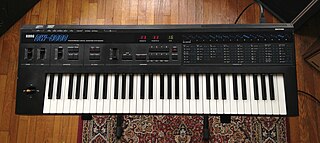
The Korg DW-8000 is a polyphonic hybrid digital-analog synthesizer released in 1985. It blends digital waveforms with an analog filter and amplifier, followed by a digital delay for adding echo effects. It boasts eight-note polyphony and its keyboard is equipped with velocity sensitivity and aftertouch.

The Korg Wavestation is a vector synthesis synthesizer first produced in the early 1990s and later re-released as a software synthesizer in 2004. Its primary innovation was Wave Sequencing, a method of multi-timbral sound generation in which different PCM waveform data are played successively, resulting in continuously evolving sounds. The Wavestation's "Advanced Vector Synthesis" sound architecture resembled early vector synths such as the Sequential Circuits Prophet VS.
The Yamaha SY85 is a digital music workstation introduced in 1992. Unlike other Yamaha synthesizers of the time the SY85 does not use FM synthesis. Instead, its sounds are based on samples, which can be layered and modified to create new sounds.

The Ensoniq VFX Synth was initially released as a performance type synthesizer in 1989. It was soon followed by the release of the VFX-SD, which included some updated waveforms, a 24-track sequencer and a floppy drive. Both models were equipped with the Ensoniq Signal Processing (ESP) chip for 24-bit effects. The VFX-SD also included two AUX outs, which allowed for a total of 4 outputs from the synth for more routing flexibility. The initial models were 21-voice polyphony, and in latter models of the VFX-SD (I/II) and the SD-1, the polyphony was 32.
The Yamaha V50 is a hybrid music workstation introduced in 1989. It combines a sequencer, rhythm machine, an FM synthesis-based sound module and a MIDI keyboard.

The Roland XP-50 is a music workstation that combines the synthesizer engine of Roland's JV-1080 sound module with the sequencing capabilities of their MRC-Pro sequencer and a 61-note keyboard. First released in 1995, the XP-50 and the Roland XP-10 were the first two Roland XP-series products, later joined by the XP-80 and XP-30.

The Korg DSS-1 is a polyphonic sampling synthesizer released by Korg in 1986. As Korg's initial entry into the sampling market, the DSS-1 combines sampling, additive synthesis, and waveform drawing with an analog signal path. The DSS-1 was released a time when major synthesizer manufacturers like Yamaha and Casio were beginning to explore sampling, an area of sound design dominated by companies like Fairlight, E-mu, and Ensoniq. Korg did not stay long in the sampling arena; the DSS-1 was the company's only sampler until 1998 when Korg introduced sampling options on their Triton and Trinity series of workstations.

Yamaha SY77 is a 16 voice multitimbral music workstation first produced by Yamaha Corporation in 1989. The SY77 is a synthesizer whose architecture combines AFM synthesis, AWM2 for ROM-borne sample-based synthesis, and the combination of these two methods christened Realtime Convolution and Modulation Synthesis (RCM). The same technology was also packaged in a rack-mounted module released simultaneously, the TG77.
The Yamaha SY99 is a synthesiser combining frequency modulation synthesis and sample-based synthesis and the direct successor to Yamaha's SY77/TG77. Compared to the SY77, it has a larger keyboard at 76 keys instead of 61, a larger ROM with more in-built AWM samples, the ability to load user-specified AWM samples into on-board RAM, an upgraded effects processor, and several other enhanced features.
The Alesis Quadrasynth is a 76-key, 64-note polyphonic PCM sample-based digital subtractive synthesizer first introduced in 1993. It was Alesis's first major foray into synthesizer production.

The Ensoniq SQ-80 is a digital/analog synthesizer manufactured from 1987 to 1989. It was Ensoniq's update to its first synth, the Ensoniq ESQ-1.
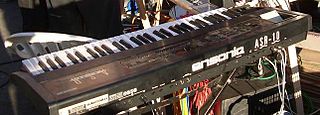
The Ensoniq ASR-10 is a sampling keyboard produced by Ensoniq between 1992 and 1998. The ASR-10 was a follow-up product to the very popular Ensoniq EPS and EPS-16 Plus performance samplers, and was also available with a piano style weighted keyboard (ASR-88) and a rackmount version (ASR-10R). At the time, the machine was one of the most powerful samplers available.